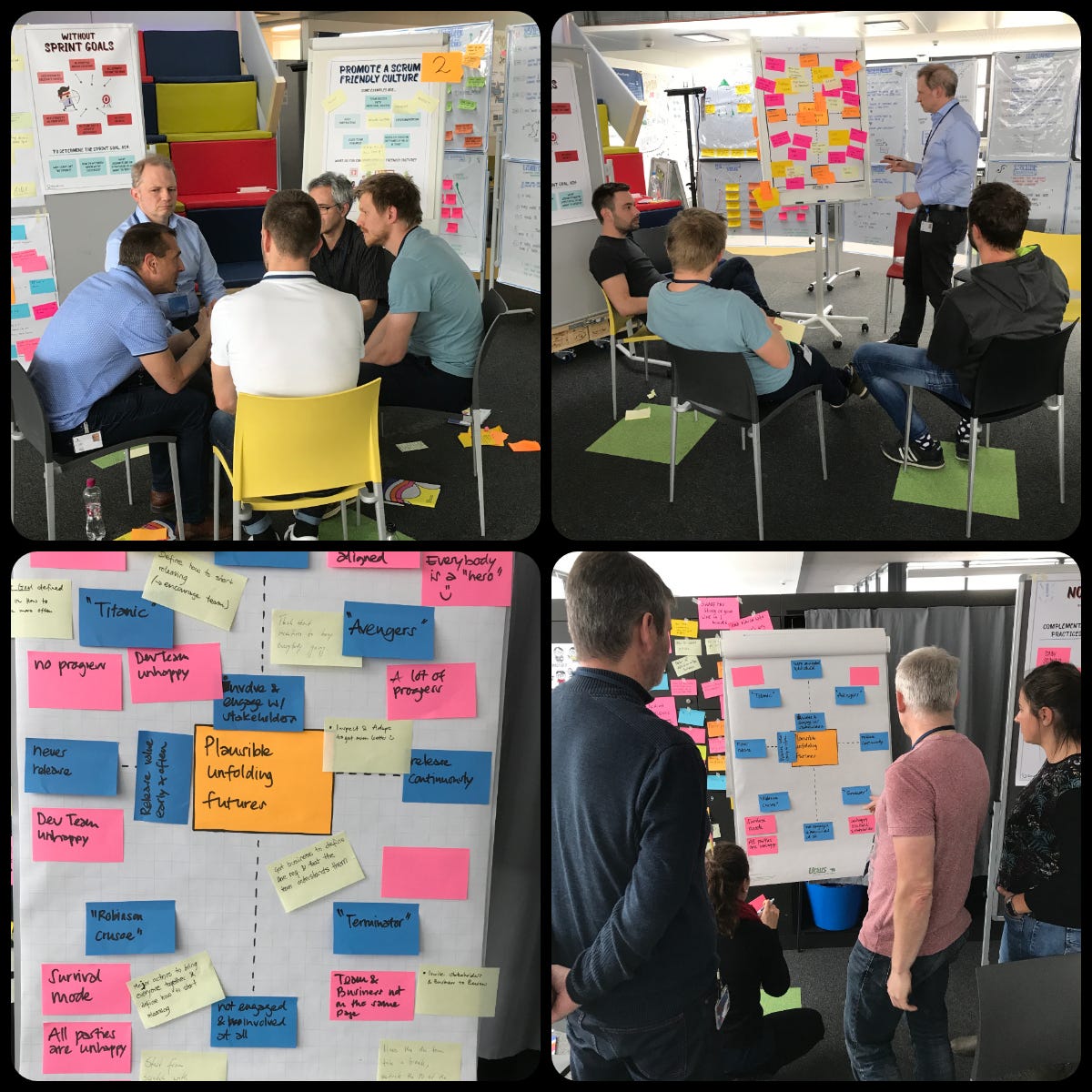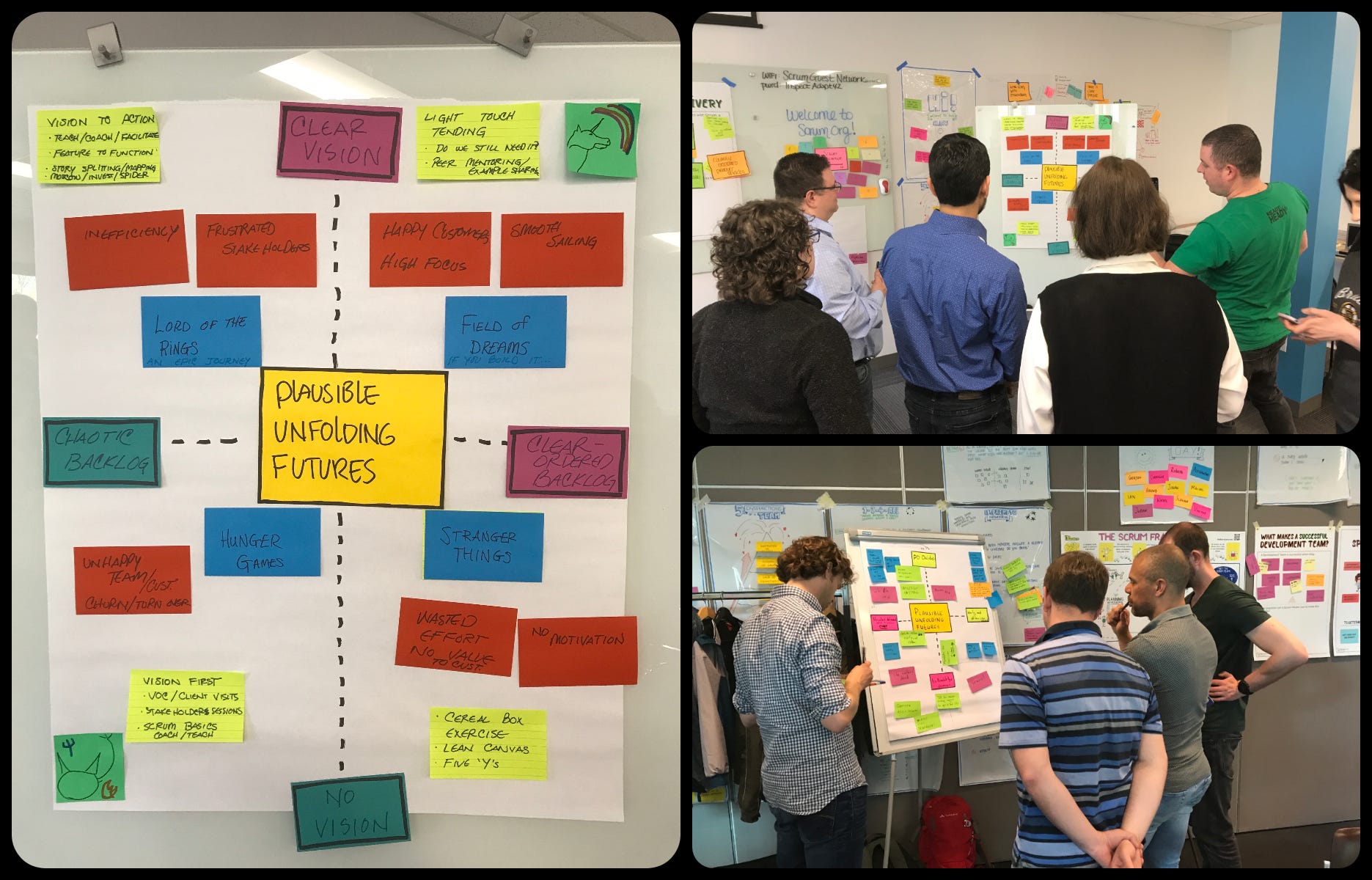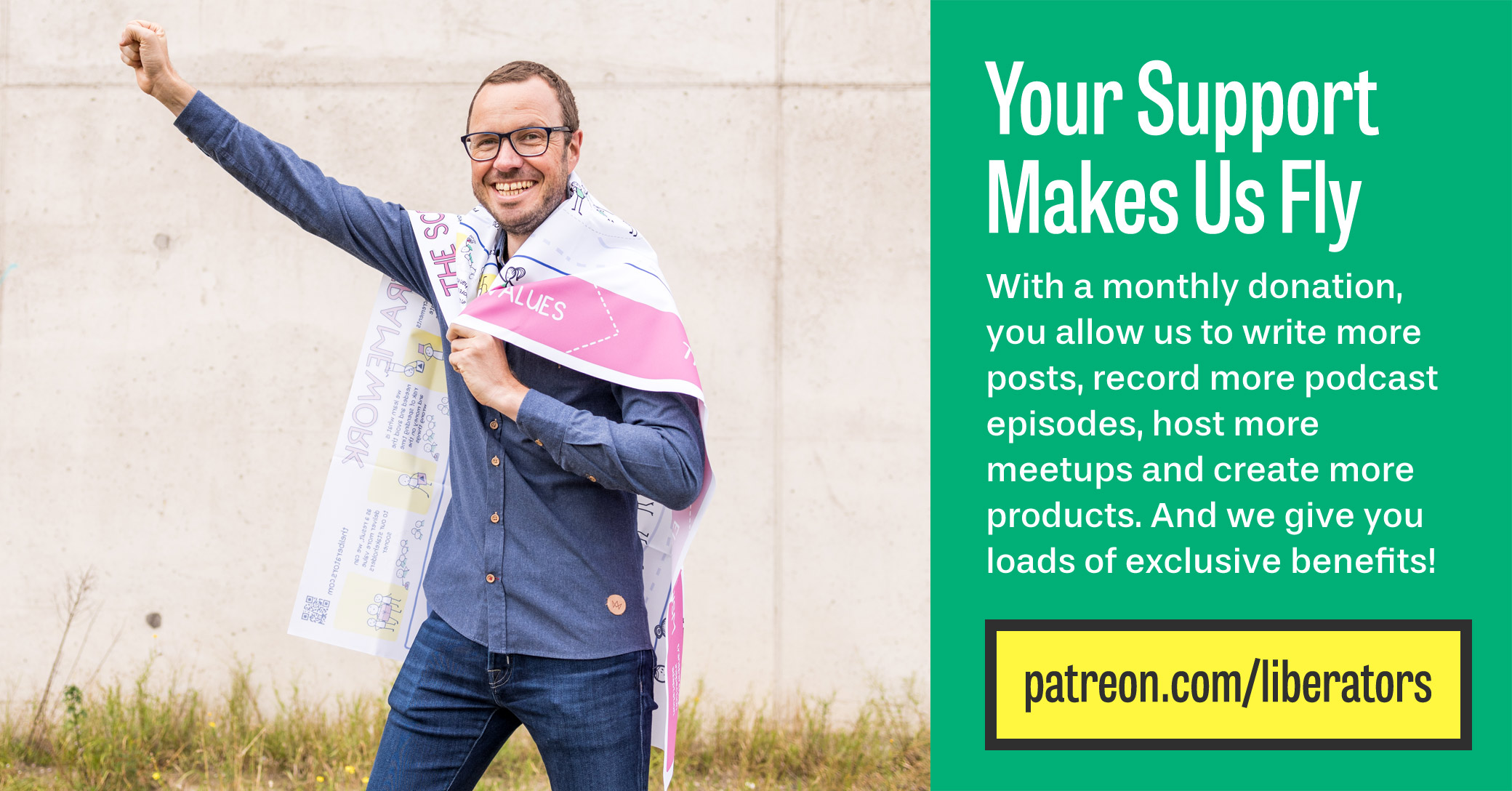Scrum is a framework that thrives on complexity. This could be complexity related to software development, product development or something else in which there is more unknown than known. By working empirically, the unknown is discovered by building small increments in an iterative rhythm. Continuously validating assumptions about what to build and how to build it.
This complexity should also be taken into account when defining the strategies — the sequence of steps — we follow to be successful. Although everyone agrees that it’s difficult (impossible?) to predict the future, strategies are commonly defined in a way that ignores this reality. Instead of offering multiple scenario’s as options, only one scenario is described in tremendous detail. When a different unexpected future unfolds, panic kicks in and the chaos starts…
This is where the Liberating Structure “Critical Uncertainties” proves it’s value. It helps to develop strategies for dealing with a range of plausible yet unpredictable futures. It enables groups to quickly test the viability of current strategies and build their capacity to respond quickly to future challenges. By using this structure, more resilience is created: the capacity to actively shape the system and be prepared to respond to change.
Although everyone agrees that it’s difficult (impossible?) to predict the future, common approaches in defining strategies seem to suggest the opposite.
How to facilitate Critical Uncertainties?
- (2 min) Explain the overall purpose of Critical Uncertainties: identifying and exploring the most critical and uncertain “realities” and formulate strategies that will help you become successful in these different situations.
- (5 min) Invite participants to form small groups and to make a list of uncertainties they face by asking: “In your environment, what factors are impossible to predict or control their direction?”
- (5 min) Prioritize the most critical factors using the question: “Which factors threaten your/our ability to operate successfully?”
- (5 min) Select the two most critical and most uncertain (X and Y).
- (3 min) Give every group a large flip chart and ask them to create a grid with two axes — X & Y — with two extremes of < — → for the factor to be represented on each axis. For example:
X-Axis: Product Owner as an analyst — Product Owner as a CEO
Y-Axis: Product Owner with a clear vision — Product Owner is clueless
- (5 min) Now that each group has four potential scenarios, invite them to explore each scenario and discover what each would look like. What behaviour might you observe? What would people say? Encourage groups to define these as “markers” they can use to determine which scenario they are in if they would “time travel” to that future. Write down some examples for every scenario, first individually and in silence (2 min) and then in the groups (3 min);
- (5 min) Invite the groups to give each quadrant a name that captures the essence of each scenario. This could be a movie title (e.g. ‘Love Boat’, ‘Endgame’), a book (e.g. ‘The Road’), a quote (e.g. ‘Shoot from the hip’) or something else that immediately captures the essence of that quadrant;
- (5 min) Invite the groups to think about which strategies could help in these scenarios, first individually and in silence (2 min) and then in the groups (3 min);
- (10 min) As an extra step, encourage the group to identify which strategies are robust (strategies that enable success in multiple quadrants) and which are hedging (strategies that are specific to one scenario and prevent catastrophy should that scenario occur). This can be done within the smaller groups, or by using a Gallery Walk in which they study the results of other groups as well.
- (5 min) Invite everyone to reflect on which scenario you currently are in and determine a 15% Solution for the strategy you defined.

Pictures of Critical Uncertainties being used at Swisscom
Examples of how we’ve used it
- Supporting the Product Owner in testing the viability of its product strategy. It helped expose assumptions and uncertainties and define next steps. Based on the different scenario’s, the Product Owner could set Sprint Goals, update the product roadmap, engage with stakeholders and offer clarity to the Development Team.
- Showing management how to involve everyone in shaping the future of the organization. As a joint effort, the possible scenarios and strategies for how to be successful were determined. This helped develop more organization-wide confidence in managing the unknowable future.
- Growing the self-organizing capabilities of the Scrum Team by having them think of the most critical and uncertain realities they might face. Doing this together not only bonded them as a team, but it also allowed them to adapt to change more quickly.
Other ideas
- Use Critical Uncertainties with the Scrum Masters in the organization to create transparency about the scenarios they might face while trying to change to the organization in order to be successful with Scrum.
- Try Critical Uncertainties with a Development Team to define strategies on how to build the product. Have them share the most critical and uncertain realities for which they need strategies in order to be successful.
- Involve your stakeholders by asking them what they consider the plausible yet unpredictable futures. For example for the product that you’re building. Together with them, define the strategies in order to be successful. This provides tremendous valuable input for the Sprint Reviews!

Pictures of Critical Uncertainties being used during the Scrum.org PSM II class
Combinations with other Liberating Structures
- Use 1–2–4-ALL, Impromptu Networking or Min Specs to answer the first question “In your environment, what factors are impossible to predict or control their direction?”
- Use the outcome of Critical Uncertainties as input for Conversation Cafe. Have a structured conversation about the key findings.
- Have each group set up a station with the outcome of Critical Uncertainties and invite them to share it via Shift & Share or a Gallery Walk
- Use Ecocycle Planning as input for Critical Uncertainties. The most critical and uncertain factors of the Ecocycle are used for defining the scenarios and strategies.
Tips & ideas
- When brainstorming uncertainties, recall predictions-gone-wrong and events that caught the group off guard
- Do this exercise step-by-step. It can be an overwhelming, mind-crushing structure. Don’t explain everything up front. Allow them to focus on the content, don’t get the groups distracted by the steps & rounds of the structure itself.
- For each scenario, invite small groups to dramatize a typical client interaction or product from the future that puts your strategies into play. This might even result in Improv Prototyping.
- Challenge wishful thinking, be provocative while walking around and offering guidance and feedback to the groups
- Use 1–2–4-All in very short cycles for each step, especially the time for individual thinking and reflection is important
- Post-it notes with coloured themes help with combining and recombining ideas. For example, yellow post-it’s are used for the name of each scenario, blue for the strategies, etc
Closing
Critical Uncertainties is a powerful Liberating Structure helping groups develop strategies for dealing with plausible yet unpredictable futures. Strategy-making is an essential part of successful software-/product delivery with Scrum. With Critical Uncertainties, teams have an interaction pattern at hand that can support them create resilient strategies. Give it a try, and share your experiences so we can learn from you as well!

See how you can support us at patreon.com/liberators
